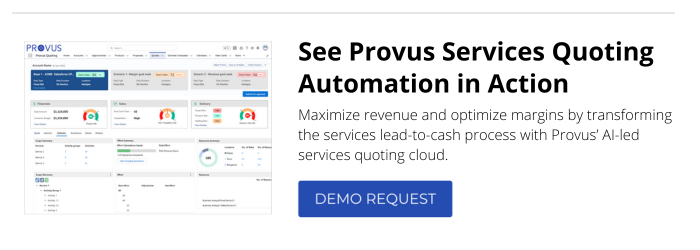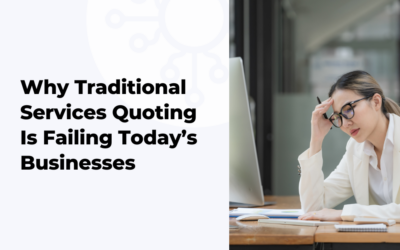Spreadsheets, it’s time to talk. For years, you’ve been at the center of the services quoting process. But lately, it’s not really working.
There’s no easy way to say this. You’re no longer enough for the doers and strategists at professional services organizations (PSOs). Their managers, directors, and VPs are looking beyond the traditional quoting landscape.
They’re looking for something more than rows upon rows of static data. Where multiple versions are stored in different locations. With inconsistent pricing formulas that don’t always transfer when you paste cells or convert to PDFs. Continuing in this way will cost them revenue, customers, and, ultimately, their jobs.
In other words, it’s time for a change.
Reasons why PSOs are moving away from the manual approach
Sales cycles are changing. Funnels are less linear. Buyers can access more information than ever before. A reported 75% of B2B buyers now prefer to avoid sales reps altogether.
At the same time, more stakeholders are involved in buying decisions. Especially when it comes to transformational technology that impacts all business functions. Global enterprises also have to factor in local behaviors in different regions. For example, Forrester highlights that 43% of buying decisions in North America are made by no more than two people in a department. Meanwhile, it’s 29% in Europe and 35% in APAC.
Basically, wherever PSOs operate, there’s increased complexity. Services quoting has to be ready to adapt, estimate, and deliver quotes faster than ever before. Any PSO using pricing spreadsheets is going to run into issues. For example:
Error-prone manual processes
You don’t have to travel far to find horror stories of costly spreadsheet mistakes – a formatting issue here, a missing digit there. With a repetitive task such as data entry, these risks won’t go away. It’s fair to say human-made spreadsheet errors are a feature, not a bug.
Lack of scalability
People move on from roles, leaving their spreadsheets behind. But their process for using particular formulas – and the business’s ability to replicate their hard-coded spreadsheets – is gone. Handover notes or ad hoc syncs only go so far as to mitigate the impact.
Unstructured data
Discounts, bundles, accessories – the more pricing components and formulas involved, the harder it is to generate accurate quotes at scale especially when you’re trying to carry out advanced margin-driven analysis, often using unstructured data.
The result is a lack of visibility and silos between teams. Naturally, this causes friction at every stage of the services sales cycle.
Sales executives can’t close without confidence in their figures. Delivery teams struggle with resource forecasting when there are sudden revisions to requirements. Finance leaders can’t accurately model revenue projections.
This lack of integration means PSOs can’t accelerate sales cycles, optimize margins, and ultimately boost revenue.
Unless they take another approach.
How quote-to-cash leads to services quoting platforms
Spreadsheets, look away now – your replacement is here. The Service Quoting Platform.
Guided Quoting at scale
With one centralized platform, PSOs can apply predefined rules and logic. This framework can be applied for Guided Quoting, to support your salespeople through the services quoting process. The result is consistent, streamlined, and scalable workflows – delivered dynamically. While also solving the complexity when individual prospects ask for discounts, plans, or other customizations.
Saving time at every stage
There’s no need to manually research, compare, or model pricing. Real-time data is available to guide service quoting. Final sign-off can be automated, with edge cases rerouted to specific managers for collaboration and resolution.
Ensuring customer satisfaction
One platform makes it possible to offer alternative scenario modeling and bundled services. Without having to wait for back-and-forth departmental discussions. PSOs can keep sales momentum high, with transparent quotes and changes.
Process automation is key to achieving results such as a 14.5% boost in sales productivity. Along with the right data that comes from robust data sources. And that comes from reliable, consistent, optimized technology and processes. Helping PSOs gather historical insight, ready for use with financial forecasts and resource planning. Rather than leaving them to rely on legacy-led spreadsheets.
Let’s look at what’s needed, and how to choose.
How to evaluate services quoting technology
Complex quoting calls for sophisticated solutions. Check out some key criteria to consider:
Scoping processes
In an ideal world, scope and components would be defined in the SOW. Where the individual subject matter experts can explain their requirements. In practice, scoping changes over time, often at short notice. Any platform should be capable of generating new quotes in real-time, helping to minimize scope creep risks while keeping a sharp eye on impacts on margins.
Advanced pricing capabilities
A services engagement involves plenty of moving parts. So a platform’s pricing has to factor in cost of living adjustments in a world of volatile interest rates. Any international payments must allow for fluctuating currencies and localized tax rates. Meanwhile, customer rate cards should be open and easily changed, by both prospects and PSOs.
Scenario modeling
Better data means AI can analyze win/loss scenarios and how these impact contracts. PSOs can also evaluate best-case and worst-case estimates. Of course, you may need integrations with your ERP, CRM, PSA, HCM, and other business-critical systems. That’s why interoperability should also be high on the list of priorities.
Collaboration and approval flows
To realize potential productivity gains, PSOs must move away from locally saved spreadsheets. They often get distributed, and duplicated, through email conversations. The alternative is creating a central record with continuous iteration. Rather than irregular, complex, and sometimes costly (in terms of downtime) updates.
Document generation
Any platform must be able to generate dynamic documents and SOWs at scale. One-click and error-free, ready for formatting for different audiences in different markets or regions.
Advanced analytics
Margin-driven analysis relies on real-time data from a reliable source of historical data. At the same time, a lot can happen between quoting and waiting for a prospect’s reply. This makes dynamic resource forecasting even more critical. Under-resourced projects are likely to fail while over-resourcing will impact budget and ROI.
The Services Quoting Platform means PSOs can become a foundation for change, improving the customer experience, maximizing revenue, and optimizing margins across People, Process, and Technology. Enabling improved resource forecasting, analytics, and customer time to value.
That’s why it’s time for PSOs to move on from spreadsheets. Towards a unified platform, built for blending immediate actions with longer-term strategies. Building relationships, engineering services, negotiating, and improvising deals on the fly, with clarity and confidence. Providing services profitably and accelerating sales cycles.
Otherwise, they and their employees risk losing business to competition or booking unprofitable deals.
We’ll be here when you’re ready.









